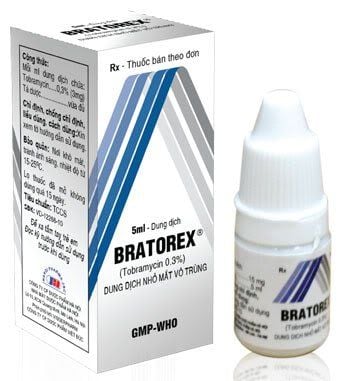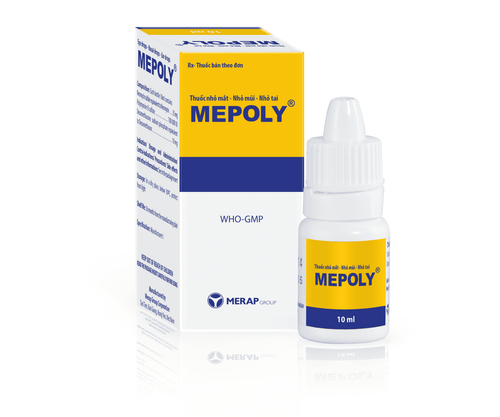This is an automatically translated article.
Chloramphenicol eye drops are indicated for the treatment of eye infections caused by bacteria. This article provides information users need to know before using Chloramphenicol.
1. What disease does Chloramphenicol treat?
Chloramphenicol contains the active ingredient Chloramphenicol and is classified as an antibiotic of the Phenicol group with the brand names Polytincol, Chloramfenicol. Prepared in the form of eye drops with the content of 5ml or 10ml of Chloramphenicol 0.4%.
The following are cases of eye infections and Cloramphenicol eye drops are indicated:
The infection causes conjunctivitis; Infection causes inflammation of the cornea ; Infection is corneal ulceration, blepharitis, blepharitis, lacrimal gland inflammation, or trachoma.
2. How to use and dose of Chloramphenicol
Before using Chloramphenicol eye drops the patient should:
Wash hands with soap and water or disinfect hands before applying eye drops; The operation of removing the cap or opening the tip of the medicine tube in case the patient uses a single-use eyedropper; Tilt your head slightly back and use one hand to gently pull the lower or upper eyelid of the eye to open the eye; The other hand holds the eye drops close to the eye so that the mouth of the eye dropper is a small distance from the eye (do not touch the tip of the tube to the eye); Squeeze the eye dropper gently to put 1 drop in the eye. If the first drop falls out, add another drop. Do the same with both eyes; Blink gently after instillation; Close the lid of the medicine or if using a disposable eyedropper, put the medicine in the correct place after use. Dosage:
The first day of using Chloramphenicol eye drops and the second day, 1-2 drops in the infected eye, 3-6 hours apart or if needed, regular drops more frequently, however, should not exceed 8 times/day; Day 3 and the following days: Patients can be instilled at intervals of 6-8 hours/time and no more than 4 times/day. Continue to use eye drops for at least 48 hours after the eye has cleared up. The above dosage is for reference only. Patients need to consult a doctor or medical staff to get the right dose.
3. Contraindications of Chloramphenicol
Chloramphenicol is contraindicated for patients in cases such as:
The patient is an infant, a child younger than 6 months old; The patient is pregnant or lactating; The patient is hypersensitive to any of the ingredients of the drug.
4. Precautions when using Chloramphenicol
During the use of chloramphenicol, the patient may experience one or more unwanted side effects. The following are the possible side effects while taking Chloramphenicol:
Common side effects of Chloramphenicol are skin rash, nausea, vomiting or diarrhea; Less common side effects of Chloramphenicol are hematopoietic disorders, which are reversible; urticaria appears on the skin; experience hypersensitivity reactions such as edema, anaphylaxis, urticaria, fever, blistering; A rare side effect of Chloramphenicol is headache; hematopoietic disorders ; problems related to the nervous system (peripheral polyneuritis, eye muscle paralysis, confusion,...). In case the patient experiences any side effects of the drug, it is necessary to stop taking Chloramphenicol and notify the treating doctor or go to the nearest medical facility for timely medical assistance.
Precautions for use:
Patients experiencing optic or peripheral neuritis should immediately stop taking Chloramphenicol. Like other antibacterial agents, long-term use of Chloramphenicol can induce the growth of other non-susceptible strains of bacteria, excluding fungi. Tell your doctor about an alternative to chloramphenicol. Avoid taking chloramphenicol with drugs that have the potential to cause bone marrow depression. During the use of Chloramphenicol, the patient did not use contact lenses. Driving and operating machines: The drug can cause blurred vision for a very short time so do not drive or operate machinery if your vision is not clear. For pregnant women: The drug is not indicated for use in this group of subjects. For women who are breast-feeding: If you must take Chloramphenicol, you should stop breastfeeding or ask your doctor to use another medicine that is more suitable. Drug Interactions: There have been no reports of drug interactions in ophthalmic formulations. In case two different types of eye drops are used, each should be instilled at least 15 minutes apart. Conditions for storing Chloramphenicol eye drops are in a dry place, the temperature does not exceed 30 degrees Celsius and avoid direct sunlight on the medicine. Above are the uses, doses and notes when using Chloramphenicol. All information through the article is for reference only, you need to use the drug exactly as directed by your doctor to ensure safety for your health.
Please dial HOTLINE for more information or register for an appointment HERE. Download MyVinmec app to make appointments faster and to manage your bookings easily.













